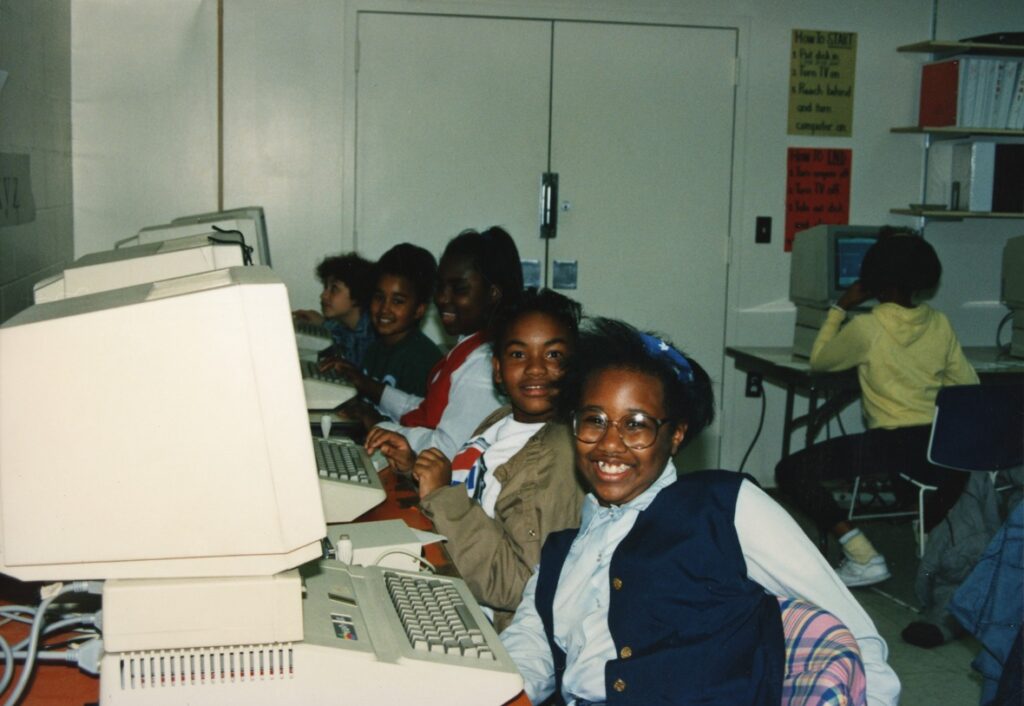
“The Honor Roll,” a mural painted by local artist Jameel Parker with neighborhood youth in 1999, encircles the Harriet Tubman House’s façade, celebrating the building’s namesake and other Black trailblazers and South End neighbors.
By Dory Klein, Community History and Digitization Specialist, Boston Public Library
Northeastern University Library’s Boston Research Center has recently launched the Harriet Tubman House Memory Project. This project aims to collect, preserve, and center the stories and memories from people affiliated with Harriet Tubman House, a much-loved community space located at the corner of Massachusetts and Columbus Ave.
This fall, photographers from the Boston Public Library took images of both exterior and interior spaces in the Harriet Tubman House, in order to preserve the Harriet Tubman House’s current spaces. In the project’s second phase, archivists, librarians, and Harriet Tubman House’s neighbors will interview past and present staff, volunteers, and community members. Their stories will offer testimony of community action and resilience, as well as the ongoing trauma of displacement through urban renewal and gentrification in the South End. Interviews are scheduled to take place over the course of the coming winter and spring via Zoom. The memories captured will be transcribed and made publicly available by Northeastern University, and will complement Northeastern’s Lower Roxbury Black History Project.

Built by United South End Settlements (USES) in 1975, area residents found a daycare, art gallery, computer lab, performance venue, shared meals, and gathering space within the Harriet Tubman House’s walls. In addition to being the base of operations for USES, the Harriet Tubman House housed nonprofits that helped Boston residents secure affordable housing, receive healthcare, earn their GEDs, develop career skills, access childcare, and cultivate community, as well as an incubator for small businesses. USES’ historical records, photographs, newsletters and other historical documentation, including records from Harriet Tubman House were donated to the Northeastern University Archives and Special Collections (NUASC) in 2002. NUASC has since made them publicly available. The oral histories gathered through the Harriet Tubman House Memory Project will add neighborhood voices to the historical record and extend the life of a beloved community space through storytelling.
In 2019, the Boston Planning and Development Agency (BPDA) voted to allow USES to sell Harriet Tubman House, and plans to develop the building are currently being finalized. Facing difficult financial circumstances, USES hopes that this sale will allow it to ensure the financial future of the organization. This decision was not without controversy; I Am Harriet, a grassroots collective of community leaders, has led efforts to prevent the sale and demolition of the building, fearing the loss of another community center in one of Boston’s most rapidly gentrifying neighborhoods.
The Harriet Tubman House Memory Project is led by the Boston Research Center, a digital community history and archives lab part of the Northeastern University Library. Working in partnership with the Boston Public Library and the Northeastern University Archives & Special Collections, the BRC works to provide a fuller picture of our city’s history by bringing together historical materials, digitizing them, and remixing and re-combining them with current data to tell the stories of Boston’s vital yet marginalized communities.
